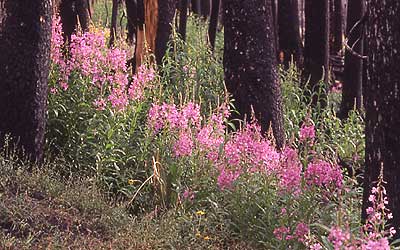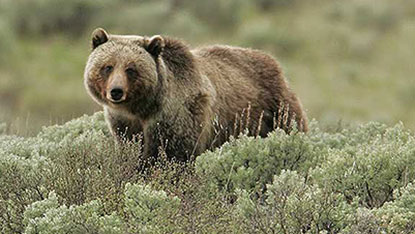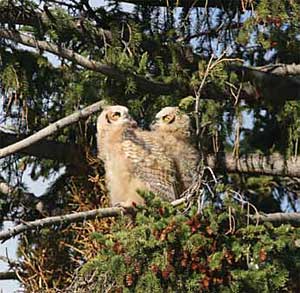Biology and Ecology
Yellowstone National Park is the centerpiece of the 20 million acre/31,250 square-mile (8,093,712 ha/80,937 km2) Greater Yellowstone Ecosystem, a region that includes Grand Teton National Park, adjacent National Forests and expansive wilderness areas in those forests. The ecosystem is the largest remaining continuous stretch of mostly undeveloped pristine land in the continental United States, considered the world's largest intact ecosystem in the northern temperate zone (although the area is mostly not temperate but subalpine, and all the national forest lands surrounding the National Park are not intact). With the successful wolf reintroduction program, which began in the 1990s, virtually all the original faunal species known to inhabit the region when white explorers first entered the area can still be found there.
Flora

Over 1,700 species of trees and other vascular plants are native to the park. Another 170 species are considered to be exotic species and are non-native. Of the eight conifer tree species documented, Lodgepole Pine forests cover 80% of the total forested areas. Other conifers, such as Subalpine Fir, Engelmann Spruce, Rocky Mountain Douglas-fir and Whitebark Pine, are found in scattered groves throughout the park. As of 2007, the whitebark pine is threatened by a fungus known as white pine blister rust; however, this is mostly confined to forests well to the north and west. In Yellowstone, about seven percent of the whitebark pine species have been impacted with the fungus, compared to nearly complete infestations in northwestern Montana. Quaking Aspen and willows are the most common species of deciduous trees. The aspen forests have declined significantly since the early 20th century, but scientists at Oregon State University attribute recent recovery of the aspen to the reintroduction of wolves which has changed the grazing habits of local elk.
There are dozens of species of flowering plants that have been identified, most of which bloom between the months of May and September. The Yellowstone Sand Verbena is a rare flowering plant found only in Yellowstone. It is closely related to species usually found in much warmer climates, making the sand verbena an enigma. The estimated 8,000 examples of this rare flowering plant all make their home in the sandy soils on the shores of Yellowstone Lake, well above the waterline.
In Yellowstone's hot waters, bacteria form mats of bizarre shapes consisting of trillions of individuals. These bacteria are some of the most primitive life forms on earth. Flies and other arthropods live on the mats, even in the middle of the bitterly cold winters. Initially, scientists thought that microbes there gained sustenance only from sulfur. In 2005 researchers from the University of Colorado at Boulder discovered that the sustenance for at least some of the diverse hyperthermophilic species is molecular hydrogen.
Thermus aquaticus is a bacterium found in the Yellowstone hot springs that produces an important enzyme (Taq polymerase) that is easily replicated in the lab and is useful in replicating DNA as part of the polymerase chain reaction (PCR) process. The retrieval of these bacteria can be achieved with no impact to the ecosystem. Other bacteria in the Yellowstone hot springs may also prove useful to scientists who are searching for cures for various diseases.
Non-native plants sometimes threaten native species by using up nutrient resources. Though exotic species are most commonly found in areas with the greatest human visitation, such as near roads and at major tourist areas, they have also spread into the backcountry. Generally, most exotic species are controlled by pulling the plants out of the soil or by spraying, both of which are time consuming and expensive.
Fauna

Yellowstone is widely considered to be the finest megafauna wildlife habitat in the lower 48 states. There are almost 60 species of mammals in the park, including the gray wolf, the threatened lynx, and grizzly bears. Other large mammals include the bison (buffalo), black bear, elk, moose, mule deer, white-tailed deer, mountain goat, pronghorn, bighorn sheep, and mountain lion.
The Yellowstone Park bison herd is the largest public herd of American bison in the United States. The relatively large bison populations are a concern for ranchers, who fear that the species can transmit bovine diseases to their domesticated cousins. In fact, about half of Yellowstone's bison have been exposed to brucellosis, a bacterial disease that came to North America with European cattle that may cause cattle to miscarry. The disease has little effect on park bison, and no reported case of transmission from wild bison to domestic livestock has been filed. However, the Animal and Plant Health Inspection Service (APHIS) has stated that bison are the "likely source" of the spread of the disease in cattle in Wyoming and North Dakota. Elk also carry the disease and are believed to have transmitted the infection to horses and cattle. Bison once numbered between 30 and 60 million individuals throughout North America, and Yellowstone remains one of their last strongholds. Their populations had increased from less than 50 in the park in 1902 to 4,000 by 2003. The Yellowstone Park bison herd reached a peak in 2005 with 4,900 animals. Despite a summer estimated population of 4,700 in 2007, the number dropped to 3,000 in 2008 after a harsh winter and controversial brucellosis management sending hundreds to slaughter. The Yellowstone Park bison herd is believed to be one of only four free roaming and genetically pure herds on public lands in North America. The other three herds are the Henry Mountains bison herd of Utah, at Wind Cave National Park in South Dakota and on Elk Island in Alberta, Canada.

To combat the perceived threat of brucellosis transmission to cattle, national park personnel regularly harass bison herds back into the park when they venture outside of the area's borders. During the winter of 1996–97, the bison herd was so large that 1,079 bison that had exited the park were shot or sent to slaughter. Animal rights activists argue that this is a cruel practice and that the possibility for disease transmission is not as great as some ranchers maintain. Ecologists point out that the bison are merely traveling to seasonal grazing areas that lie within the Greater Yellowstone Ecosystem that have been converted to cattle grazing, some of which are within National Forests and are leased to private ranchers. APHIS has stated that with vaccinations and other means, brucellosis can be eliminated from the bison and elk herds throughout Yellowstone.
